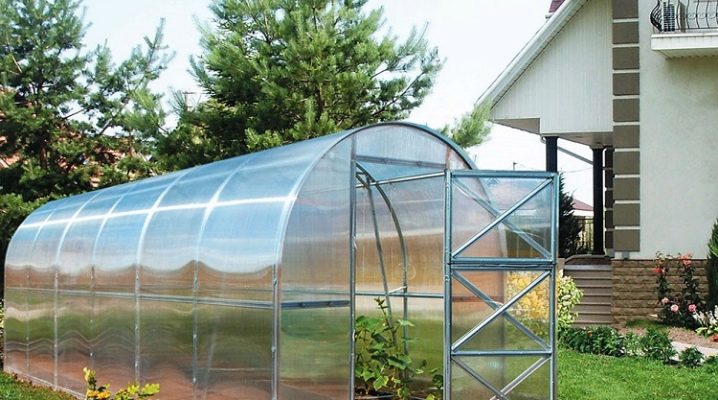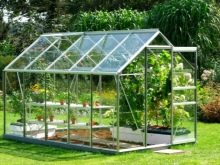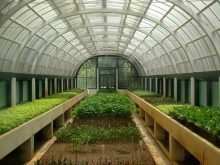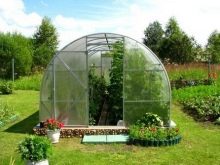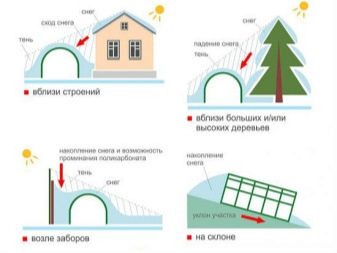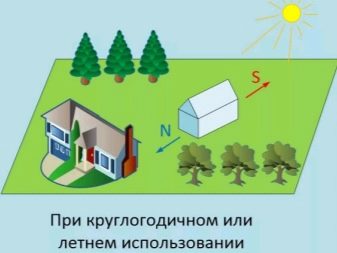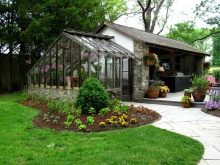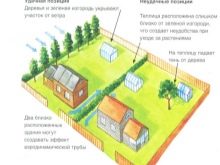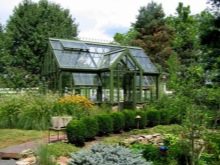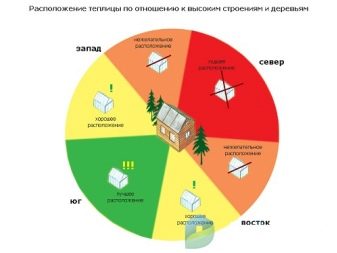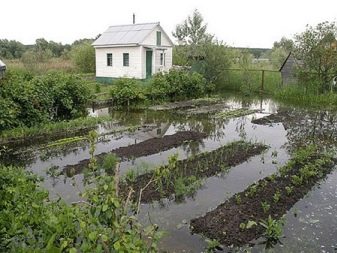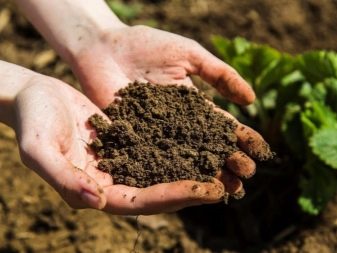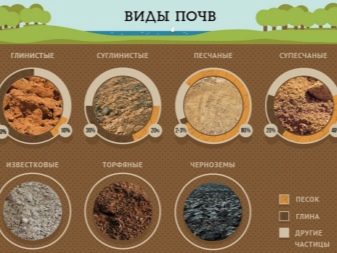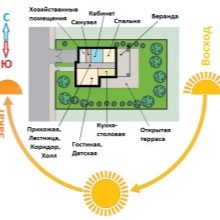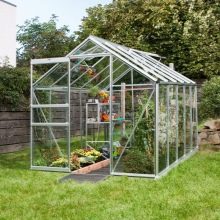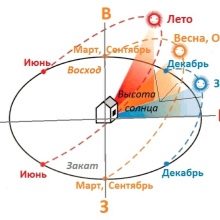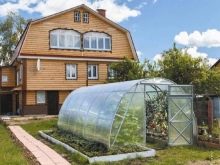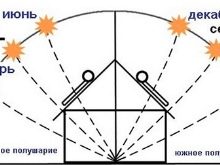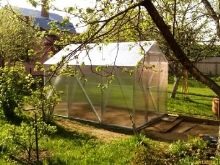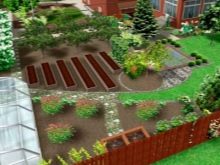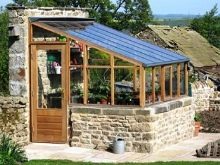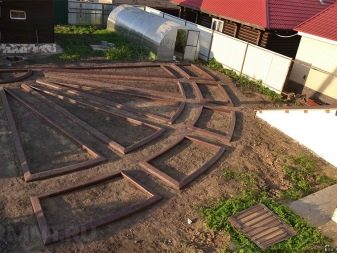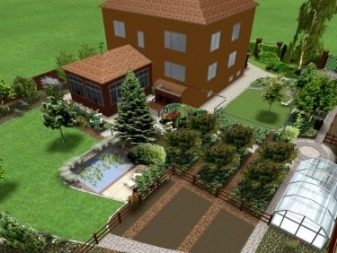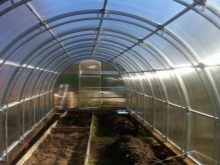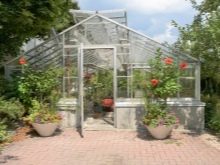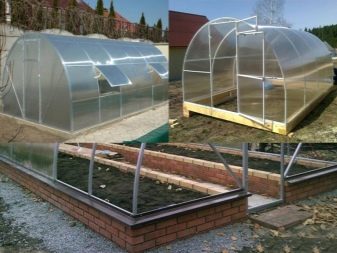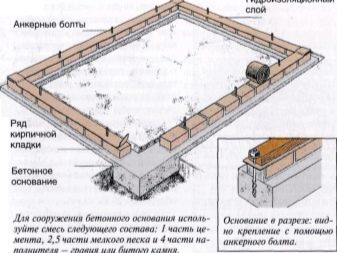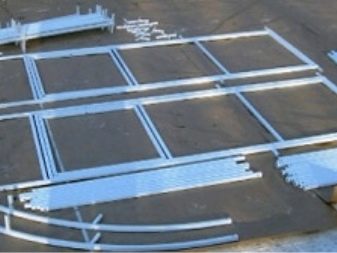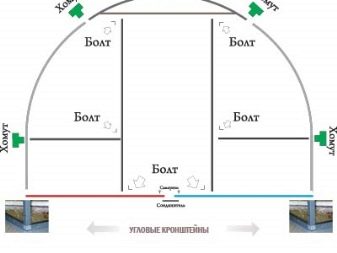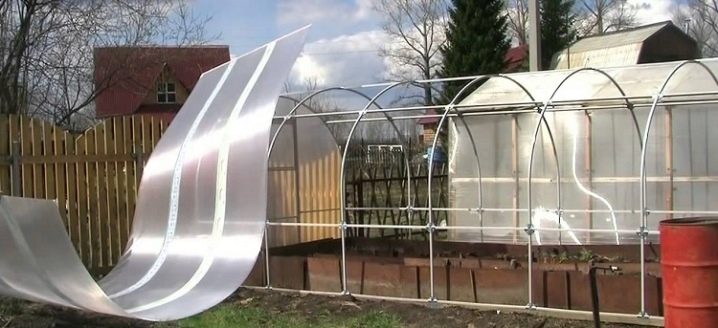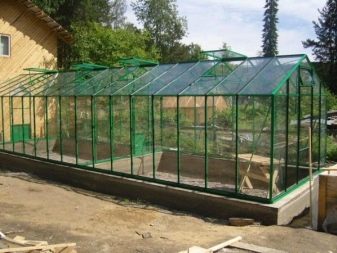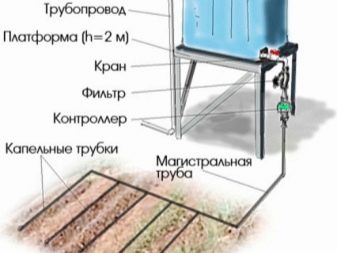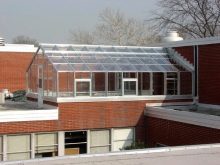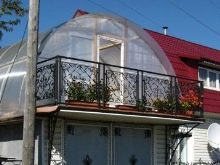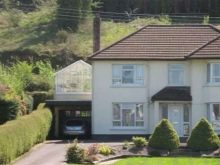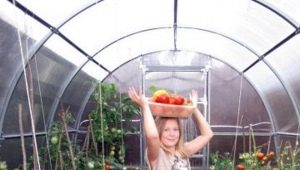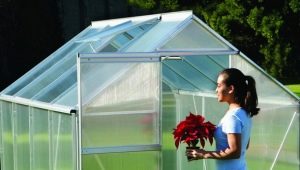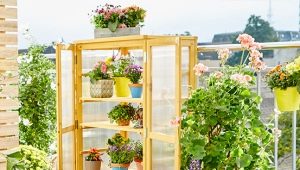How to locate the greenhouse in the parts of the world?
The correct location of the greenhouse on the plot is one of the determining factors affecting crop yields and the condition of the plant as a whole. We will talk about this in our article.
The main criteria for selecting a site
Proper and reasonable choice of place, taking into account the characteristics of the terrain, soil type, degree of insolation, intensity of wind flow and humidity, is considered the key to productivity in growing vegetables. Before you start building a greenhouse or greenhouse, you should carefully examine all the features of this site. When determining the location of the greenhouse construction, one should take into account the combination of all factors that in one way or another affect the growth and development of plants, since neglecting one of them can lead to the futility of previous calculations and negate their effectiveness.
The location of the greenhouse on the cardinal points is an important, but not the only factor that must be considered when building greenhouses. Therefore, each of them should be subject to careful examination and study.
Relief effect
- The first step in choosing a site for the construction of the greenhouse should be the study of the terrain and landscape of the backyard plot. The best place to place a structure is a flat, without a slope, a site located at a distance from tall trees and shrubs with a dense crown.
If the forest begins immediately after the plot, then the greenhouse should be removed as far as possible from the fence. This is due to the fact that the powerful root system of adult trees will take a significant part of moisture and nutrients, and without organizing an additional layer of fertile soil inside the greenhouse, it will be difficult for plants to develop and bear fruit normally. In addition, in a certain period of daylight, tall trees will shade the greenhouse, as a result of which the plants will not receive the necessary amount of sunlight and heat.
- The second important point affecting the placement of greenhouse structures is the slope angle of both the site as a whole and the specific site where construction is planned.If the entire site is located on a mountainside, then, most likely, during its development, it will be necessary to use the layering technology. For greenhouses in such cases, choose one of the upper tiers.
This requirement is due to the fact that when located in the lower part of the plot, the greenhouse will act as an artificial barrier for rain flows. As a result, the lower part of the basement will constantly erode and quickly become unusable.
At the same time, excess water will begin to accumulate near the upper wall of the greenhouse, to be absorbed into the ground and cause excessive waterlogging of the soil inside the structure. This will lead to rotting of the root system of the plants, and they will die. The way out of such situations is the construction of an artificial mound of rubble or the installation of piles.
- Another important factor affecting the installation site of the greenhouse is the groundwater level. However, in the absence of the ability to conduct hydrological surveys, the proximity of their location can be recognized by the plants growing in this area. Thus, the presence of reeds suggests that the water is at a depth of 1-3 meters, wormwood - at 3-5 m, and cattail and licorice - at 1-1.5 meters.At the closest location of the aquifers, the grass on the site acquires a bright green juicy color, which significantly differs from the grasses of more arid places.
The willow, alder, currant and meadowsweet growing on the site show high natural soil moisture. Do not have a greenhouse in such places. This increases the risk of flooding the building with a sharp increase in the level of groundwater, as well as a negative impact on the root system of many plants. If it is impossible to transfer the greenhouse to a drier area, it is necessary to build a drainage system and organize an effective catchment network.
Soil composition and structure
The composition and fertility of the soil also plays an important role when choosing a site for a greenhouse. For example, the presence of clay adversely affects the growth and development of seedlings, therefore, it is undesirable to install a greenhouse on clay areas. This is explained by the fact that the clay does not allow moisture to be absorbed into the ground and leads to water stagnation in the upper layers of the soil. As a result, the roots begin to rot, which causes the death of plants. The best option for the installation of greenhouses are sandy and sandy sandy soils, which are filled with fertile soil on top.However, if the clay deposits are located in the entire area, it is recommended to remove the clay layer, put drainage on the bottom of the dug pit and cover it with sand. Next you need to place a layer of fertile soil, after which you can proceed to the construction of the greenhouse.
In addition to the level of fertility and the capacity of the soil, it is necessary to pay attention to the density of the earth. This is due to the fact that on unstable soils there is a high probability of soil movements, as a result of which the windows and doors will no longer close, the frame is deformed, and the coating material will simply break. The way out of this situation is the arrangement of the foundation, which will not allow the structure to warp and ensure its integrity and durability.
Insolation
The optimal location of the greenhouse relative to the trajectory of the sun is its placement from east to west. In this case, the illumination of the structure will be most effective, and the rays of the sun will be directed to the seedlings throughout the daylight hours. This will contribute to a more uniform distribution of heat within the structure and will give the opportunity to grow vegetables throughout the growing season.
When oriented greenhouses from south to north, the lighting will be extremely uneven, and seedlings planted closer to the north side, will begin to lag significantly in growth and development. The solution to this problem may be the installation of additional light sources, but this will lead to significant energy consumption and make the cultivation of vegetables unprofitable and impractical.
However, it often happens that due to the small area of the summer cottage, it is impossible to place a greenhouse from west to east. In this case, you need to have so that the building is well lit and warmed up in the morning and pre-dinner hours. This requirement is due to the fact that it is in the early morning that there is a noticeable decrease in temperatures inside the greenhouse, during which young plants most urgently need warmth.
Otherwise, the seedlings will develop poorly, and the actual crop yield will be far from expected. The decrease in the amount of the crop caused by the lack of heat is due to the fall of a large number of ovaries due to the violation of insolation. Conversely, intense lighting and a sharp influx of heat in the second half of the day can cause burns on the leaf plates that have frozen overnight, and have a negative impact on their future development.
Distance from buildings
Another important requirement for lighting greenhouses is the absence of nearby greenhouses, baths, fences and outbuildings. Their close location can create long-term shading and deprive the plants of ultraviolet radiation. The distance from the greenhouse to the nearest facility should be such that, on the one hand, there is no shading of the greenhouse structure, on the other hand, it is convenient if necessary to carry out additional heating and lighting. Therefore, the proximity of the location of communications should also be taken into account.
This is especially true of year-round greenhouses, equipped with a heating system and connected to the appropriate engineering networks. During their construction, it is desirable to draw up an arrangement of trees, beds and shrubs relative to the future greenhouse and find the shortest way for laying pipes. An important criterion when choosing a place for the greenhouse is the possibility of unhindered access to the building with buckets and garden wheelbarrows. Too narrow aisles will interfere with the free passage with garden tools and complicate the care of greenhouse plants.
Measures to reduce the impact of negative factors
The internal microclimate and the general condition of the plants depend on how well the greenhouse will be installed on the site. In case of unsuccessful location of the structure It is necessary to take a number of measures that can reduce or level the negative impact of environmental factors on plants.
- Due to the limited area of the plots, a greenhouse is often established between two buildings, for example, a house and a bath. The result is the effect of a wind tunnel, and drafts begin to walk between the two buildings. Air flow can significantly change the temperature inside the greenhouse and can lower it by 5 degrees. Such a decrease is very sensitive for young plants: under the influence of drafts, growth slows down, and flowering and fruiting periods are shifted.
In order for an unfortunate arrangement of the greenhouse structure not to affect the yield, the plants should be protected from excessive wind load. To do this, you can install a protective screen or planted not very high, but dense bushes, which will serve as a hedge. However, during their landing, one should not forget about the likely shading of the greenhouse, therefore, it is necessary to plant bushes at a distance of at least three meters from it.The protective screen can be made of slate sheets and also installed no closer than three meters from the greenhouse structure.
- Among the negative factors affecting the growth and development of plants are possible heat loss caused by the unfortunate location of the greenhouse or blemishes during its installation. The risk of penetration of cold masses to a greater extent applies to greenhouses that have no foundation and installed directly on the ground. In order to prevent the seedlings from freezing, it is recommended to raise the beds to a height of 50 cm.
This will allow the roots to be in the layer heated during the day, which will favorably affect the well-being of the bushes. In addition, careful treatment of the joints of the covering material with a moisture-resistant sealant will help to keep warm.
However, with the elimination of gaps in the joints, one should not forget about the ventilation of the greenhouse. The total surface area of the vents and transoms should be at least 25% of the total area.
Mounting technology
Subject to the rules of installation and safety, You can install the greenhouse construction at your summer cottage yourself.
- After the site for construction is chosen, it is necessary to start its preparation.To do this, it is necessary to clear the site, which is 70-100 cm above the length and width of the greenhouse. If the surface is relatively flat, then you can start building the foundation.
- In general, the presence of the foundation is not a prerequisite for the construction of greenhouses and greenhouses, but in conditions of unstable soils, as well as heavy and frequent rainfall, it is necessary to build a foundation. Otherwise, its absence with time will lead to the deformation of the frame, which may violate the overall integrity of the greenhouse.
- For the arrangement of the foundation for greenhouses and greenhouses used concrete mortar, wooden beams, bricks or natural stone. The timber must be treated with a special solution that prevents rotting of the wood and protects it from parasites. If the organization of heating or drip irrigation is planned in the greenhouse, it is necessary to take care of the connection and connection of communications at the stage of arrangement of the foundation.
- After the foundation is ready and the necessary engineering networks have been established for the future structure, it is necessary to expand all the elements and details of the greenhouse on the ground. In this case, it is desirable to observe the sequence, and arrange the elements in the sequence in which the installation will be carried out.
- Assembly is recommended to start with the installation of end parts and support arcs. At the same time, it is necessary to periodically check the verticality of their location using the construction level. Next, install the transverse elements, after installation of which produce hanging doors and transoms. In the absence of the need to build a foundation, the base of the frame is instilled in to a depth of at least 80 cm.
- The final stage of assembly will be laying of polycarbonate sheets, which can be carried out either with the help of an H-shaped profile butt or with overlap. In the first case, the appearance of the greenhouse will be much neater and more aesthetic. However, this method requires the purchase of additional fasteners, which entails extra costs. In addition, when laying polycarbonate in the grooves, it is recommended to treat the end of the sheets with alcohol, and the grooves themselves are coated with silicone grease.
Such measures are necessary to prevent leakage of the greenhouse, as well as to avoid the appearance of drafts. Laying material overlap does not look so aesthetically pleasing, but it allows you to do without additional measures to improve the tightness of the joints.
Compliance with the installation technology and the execution of the assembly sequence will allow you to build a reliable and durable greenhouse that can last for more than a dozen years.
Useful tips
It would seem that after the site is defined, and the greenhouse design is installed, you can proceed to its operation. However, in order to get a rich harvest and extend its life, It is necessary to take into account some recommendations of experienced gardeners.
- When building a greenhouse, the angle of inclination of the roof should correspond to 25 degrees. This design contributes to a more uniform heating and is considered to be the most streamlined in wind gusts.
- If there is a possibility of summarizing communications, then it is better to organize a drip irrigation system in the greenhouse. This will allow to evenly moisten the soil and eliminate the need to carry heavy watering cans and pull the hoses.
- The best option for the location of the greenhouse is to place it on the roof of a residential building. This will provide the plants with the maximum amount of solar energy, significantly save space on the site and save the crop from marauders in the absence of owners.The main requirements of this location are a small weight of the structure, reliability of fasteners, the possibility of summarizing communications and the organization of waterproofing attic floors.
- When using the greenhouse for several years, the soil begins to lose its natural fertility. As a result, yields are reduced and fruit quality is deteriorating. To prevent this from happening, green manure should be planted in late autumn or early spring, and mineral fertilizers and organic fertilizers should be regularly added to the soil.
Thus, the convenience of caring for plants, the service life of the structure and the possibility of obtaining a rich harvest depend on the location of the greenhouse on the site.
For information on how to properly position the greenhouse on the land plots, see the following video.
